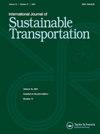Dynamic model to assess the impacts of government support for electric vehicles on the economy and environment sectors in Indonesia
IF 3.1
3区 工程技术
Q2 ENVIRONMENTAL STUDIES
International Journal of Sustainable Transportation
Pub Date : 2025-01-02
DOI:10.1080/15568318.2024.2443825
引用次数: 0
Abstract
This research proposes a comprehensive analysis of the environmental and economic impacts of electric vehicle (EVs) adoption using system dynamics modeling. A system dynamics framework is utilized to integrate various aspects of EVs, economy, environment, and impact of policies on those sectors. Stock and flow diagrams were used to model and predict the impact of government support on electric vehicles based on the existing and future conditions through several proposed strategies. This research mainly contributes to providing causal relationships of variables and parameters influencing the number of EVs and their impact on the economy and environment, modeling and simulation of several sub-systems based on the existing condition, and scenario modeling to predict and improve the number of EV, economic value, and environmentally friendly in the future. This research examines how different policies for electric vehicles (EVs) might affect the numbers of people use them, the pollution caused, and the cost spent. They looked at total emissions, yearly budget, and the number of electric cars and motorcycles. The results show that continuing or increasing government help (scenarios SCN2 & SCN3) for EVs leads to the biggest pollution reduction. Focusing on developing new technologies and industries for EVs (SCN4) shows the biggest short-term pollution reduction. The key takeaway is that long-term support for EVs and technological advancements are essential for success. Finding a balance between the initial costs and the long-term benefits is crucial when designing policies for EVs.
动态模型,以评估印尼政府支持电动汽车对经济和环境部门的影响
本研究采用系统动力学模型对电动汽车的环境和经济影响进行了综合分析。系统动力学框架用于整合电动汽车、经济、环境和政策对这些部门的影响的各个方面。根据现有和未来的情况,通过几种拟议的策略,利用库存图和流程图来建模和预测政府支持电动汽车的影响。本研究主要提供影响电动汽车保有量的变量和参数及其对经济和环境影响的因果关系,基于现有条件对多个子系统进行建模和仿真,通过情景建模对未来的电动汽车保有量、经济价值和环境友好性进行预测和改进。这项研究考察了不同的电动汽车政策如何影响使用电动汽车的人数、造成的污染和花费的成本。他们考察了总排放量、年度预算以及电动汽车和摩托车的数量。结果表明,持续或增加政府援助(情景SCN2 &;电动汽车的SCN3是减少污染最多的。专注于开发新技术和新产业的电动汽车(SCN4)显示出最大的短期污染减少。关键是,对电动汽车的长期支持和技术进步是成功的关键。在设计电动汽车政策时,在初始成本和长期效益之间找到平衡至关重要。
本文章由计算机程序翻译,如有差异,请以英文原文为准。
求助全文
约1分钟内获得全文
求助全文
来源期刊
CiteScore
8.90
自引率
2.60%
发文量
56
期刊介绍:
The International Journal of Sustainable Transportation provides a discussion forum for the exchange of new and innovative ideas on sustainable transportation research in the context of environmental, economical, social, and engineering aspects, as well as current and future interactions of transportation systems and other urban subsystems. The scope includes the examination of overall sustainability of any transportation system, including its infrastructure, vehicle, operation, and maintenance; the integration of social science disciplines, engineering, and information technology with transportation; the understanding of the comparative aspects of different transportation systems from a global perspective; qualitative and quantitative transportation studies; and case studies, surveys, and expository papers in an international or local context. Equal emphasis is placed on the problems of sustainable transportation that are associated with passenger and freight transportation modes in both industrialized and non-industrialized areas. All submitted manuscripts are subject to initial evaluation by the Editors and, if found suitable for further consideration, to peer review by independent, anonymous expert reviewers. All peer review is single-blind. Submissions are made online via ScholarOne Manuscripts.

 求助内容:
求助内容: 应助结果提醒方式:
应助结果提醒方式:


